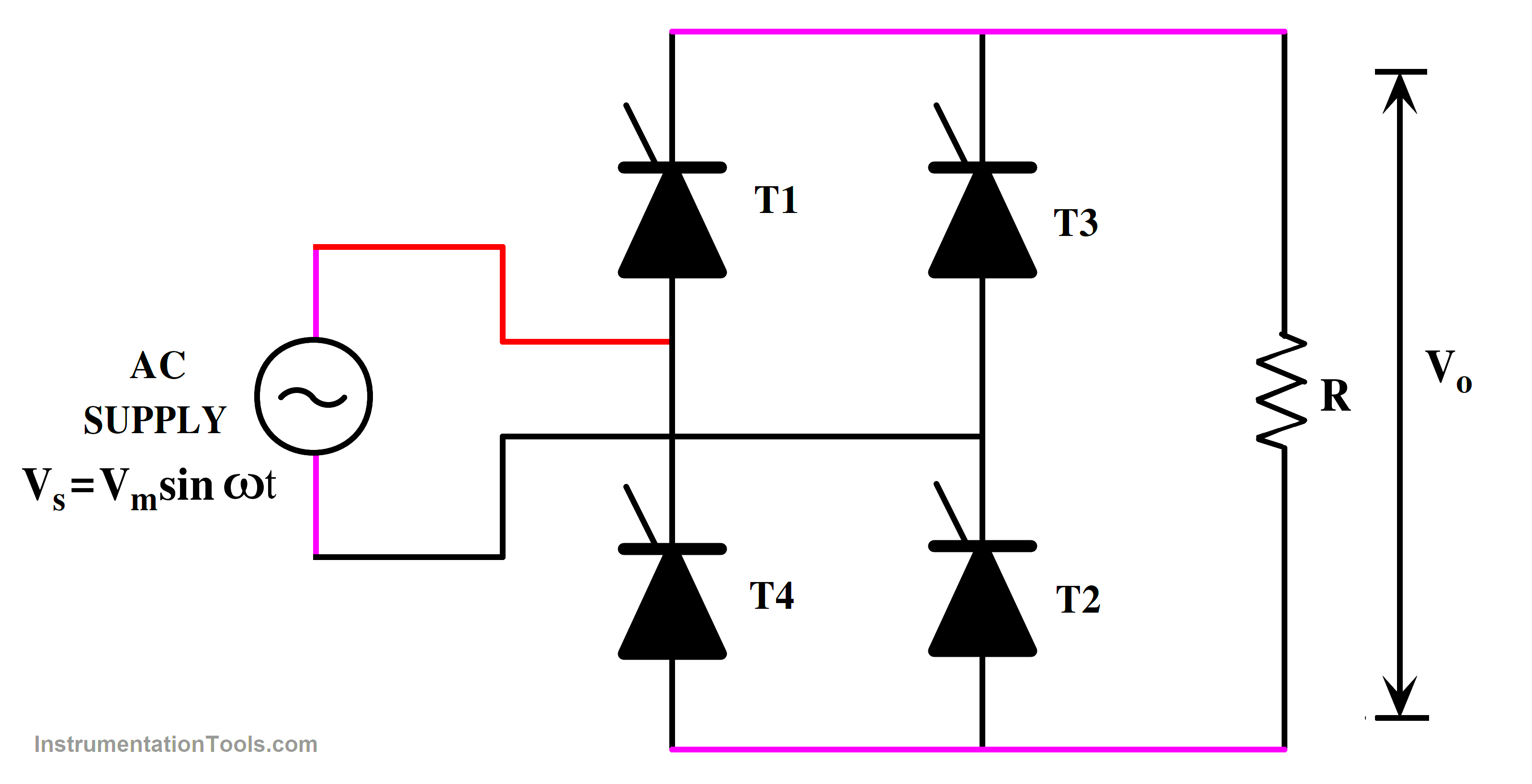The single-phase fully controlled rectifier allows the conversion of single-phase AC into DC. All four devices used are Thyristors.
The supplied firing signals determine the instants at which these devices switch on.
Turn-off happens when the current through the device reaches zero and it is reverse biased at least for a duration equal to the turn-off time of the device specified in the datasheet.

Fig 1. Single Phase Full-controlled Rectifier R Load
Fig 2. Single-phase Full-controlled Rectifier RL Load
AC Power Supply: The input power source is typically an AC supply.
Thyristor(s) (SCR): Thyristors are semiconductors that act as controlled rectifiers. Since the above circuit is a bridge circuit. It consists of 4 thyristors.
The article consists of two circuits namely R load and RL load
Resistor (R): A resistor may be connected in series with the inductive load to limit the current.
a. Positive Half-Cycle
The thyristor is triggered into conduction at α (firing angle) during the positive half-cycle of the input AC voltage. The conductivity of the thyristor enables current to move through the load (R) and thyristor (T1 & T2) simultaneously.
Fig 3.1 – Working of Full Converter During Positive Cycle
The input voltage changes polarity at the conclusion of the positive half-cycle, resulting in the thyristor’s natural shutdown.
b. Negative Half-Cycle:
The thyristor (T1&T2) is reverse-biased and does not conduct during the negative half-cycle of the input AC voltage. However, during this half-cycle, the thyristors (T3 & T4) conduct, and current flows through the load.
Both the output voltage and current are positive cycles in this setup. This is a result of the load being positive with regard to the ground throughout both cycles.
Similar to this, the thyristor (T3 & T4) is off during the positive cycle, and the input voltage changes polarity causing the thyristor to naturally turn off.
Fig 3.2 – Working of Full Converter During Negative Cycle
The single-phase full-wave circuit’s average voltage VO over load R is calculated as follows:
a. Positive Half-Cycle:
During the positive half-cycle of the input AC voltage, the thyristor (T1 & T2) is triggered at α (firing angle) into conduction. The thyristor conducts, allowing the current to flow through the inductive load (RL) and the thyristor. The load current rises, and energy is stored in the inductor.
At the end of the positive half-cycle, the input voltage reverses polarity, causing the thyristor (T1 & T2) to naturally turn off.
The inductive load tries to maintain the current flow after the thyristor turns off. However, since the thyristor is off, the load continuously conducts until the charges are present in the inductor. But the inductor discharges current in the reverse direction.
b. Negative Half-Cycle:
During the negative half-cycle of the input AC voltage, both the thyristor (T1 & T2) do not conduct. No current flows through the load during this half-cycle using T1 & T2.
Thyristor T3 & T4 conducts during the negative cycle. Similarly, the inductor stores the charges during the negative cycle.
At the end of the negative half-cycle, the input voltage reverses polarity, causing the thyristor (T3 & T4) to naturally turn off. However, the load continuously conducts until the charges are present in the inductor in the reverse direction.
The single-phase full-wave circuit’s average voltage V0 over load RL is calculated as follows:
When α= 90°, the output voltage will be zero. It implies that there will be an equal amount of positive and negative areas in the output voltage, resulting in zero output voltage.
The converter functions in inversion mode for firing angles α greater than 90°. For α = 180, the voltage will be maximally negative.
Fig 4.1 Full Controlled Rectifier With R Load Output Waveform
Fig 4.2 Full Controlled Rectifier With RL Load Output Waveform
Fig 5. Single Phase Full Bridge Converter With R Load
Fig 6. Simulink Circuit of Full-controlled Rectifier R Load
Fig 7. Simulink Response of Full-controlled Rectifier R Load
Fig 8. Simulink Response of Full-controlled Rectifier R Load
If you liked this article, then please subscribe to our YouTube Channel for Instrumentation, Electrical, PLC, and SCADA video tutorials.
You can also follow us on Facebook and Twitter to receive daily updates.
Read Next:
Omron PLC logic for sorting the number of products and counting the number of products…
Learn the water fountain control logic using the PLC timers programming to control the high…
Open Telemetry is a framework for collecting data in cloud-native applications including tracing, metrics, and…
This article is about controlling the Pneumatic cylinder and Pneumatic motor in the assembly line…
In this post, we will learn the basic requirements for a network switch to be…
The PLC panel and MCC panel interface signals are start, stop, run feedback, trip, local…